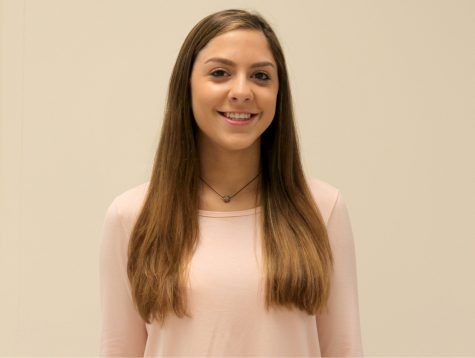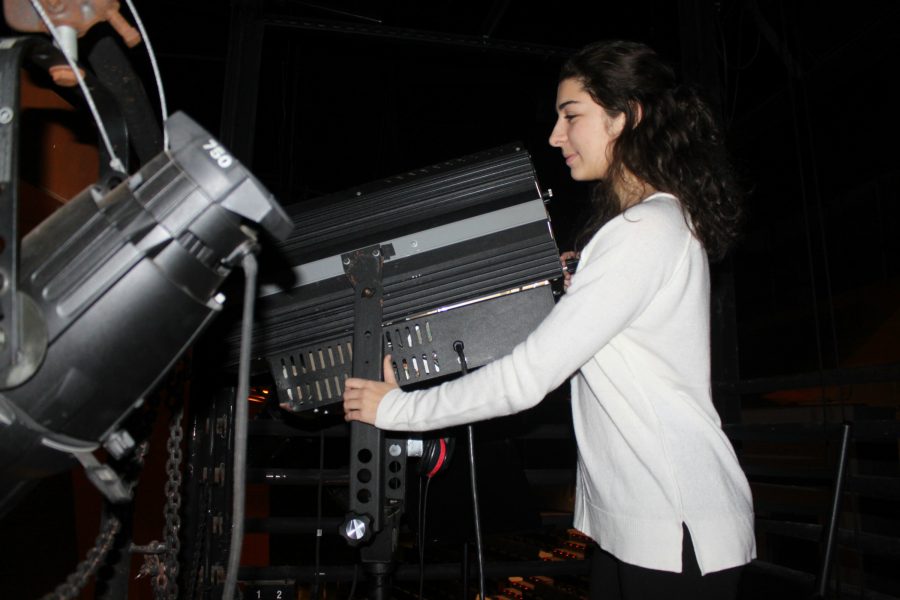Behind the Lights
If her job is done right, you will not notice her. If she was not there, you would notice her, yet she managed to be the spotlight of the show. Lindsey Lasiewicz, junior in lighting crew, has learned about this first hand and has become the lady behind the lights.
“[Lighting] definitely adds different moods to the scene that sometimes the acting, singing, and dancing, can’t portray exactly,” Lasiewicz said. “Then there are different ways to position the lights so that there are different shadows on your face, so it’s very detailed.”
According to Lasiewicz, the artistic aspect and ability to get creative with the lights is the reason she chose to learn more about it and pursue lighting.
“We have different workshops for everything so you learn a little bit about lighting, sound, and stagecraft,” Lasiewicz said. “After two lighting workshops, I realized that I really liked it and that it was interesting. After that, I worked my butt off [in rehearsal] to get to where I am now.”
It is not easy to learn the ins and outs of stage lights, Lasiewicz explained, but she had the help of friends who seemed like experts in the art.
“All my friends are in tech [crew], so this year I really dedicated more of my time to it than in the past years,” Lasiewicz said. “[My friends] knew a lot about lighting, and they really took me under their wing when they knew that I was interested in it and have been helping me and teaching me a lot.”
While Lasiewicz dedicates rehearsal time to learning more, there is always more for her to experience, she says. However, she is not on her own. She has an entire crew guiding her along the way.
“There’s a lot to learn,” Lasiewicz said. “Especially with [the different parts of] technical theater, you can never stop learning. I think that because my friends are so skilled in it and they know so much, that learning it from them was a lot easier than learning from a book.”
In learning how to control the lights, Lasiewicz also learned the different jobs associated with the lighting.
“I think lighting is important, and not only because it’s what I enjoy doing. Look around, all you can see, lighting has a part in it. [In your house, on buildings, sports, concerts] in my case, theater, lighting makes a show a show,” Kyle Bajor, senior in lighting crew, said. “It adds another dimension, it drives the audience’s focus to where it’s supposed to be, it can mimic magic, it can evoke emotion, and it brings all the pieces together.”
Bajor has worked as both lighting designer and electrician, in addition to helping Lasiewicz learn the ins and outs of the lights.
“There’s a crew of electricians who hang the lights and focus them, there’s a lighting designer, and an assistant lighting designer,” Lasiewicz said. “The electrician’s job is basically that after the shows, I help the lighting designer do the electrical work.”
Although all the electricians have different jobs, Lasiewicz said, they spend lots of time working together to make the show the best that it can be.
“It’s a really long process, a lot of hard work and long hours go into it,” Lasiewicz said. “In the beginning of the process, [we meet] two to three times a week for two hours and Saturdays from 10 to 4. Then it’s everyday until 5:30 or 6:30, plus the Saturdays.”
According to Lasiewicz , the entire crew dedicates their time to perfecting their performance, and lighting is no exception.
“When things go wrong, we rehearse it so many times that we know what to do to fix it as quick as possible,” Lasiewicz said. “Every time the rehearsal is over, I meet with the lighting designer and go over notes, so I get to work closely with them.”
While rehearsals can be long and require a lot of work, seeing all the pieces of the show come together makes all their hard work well worth it, according to Lasiewicz. However, according to Bajor, Lasiewicz does not give herself enough credit.
“Lindsey has been an awesome master electrician. It’s her dedication, carefree personality, curiosity, and leadership skills. There’s never a dull moment around her, but once there’s work to be done, she’s asking questions, trying to learn as much as possible, and retaining it,” Bajor said. “Having her on the team is a great resource. I know I can trust her with a task and know that she will get it done, or ask around until she can get it done.”

Dominique is the LZ Life Editor (aka the best section). Aside from Bear Facts, she spends her free time with her friends and getting involved in the...

